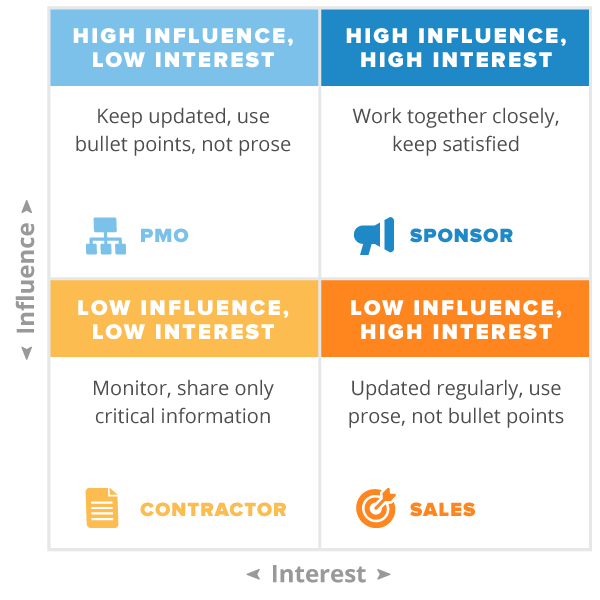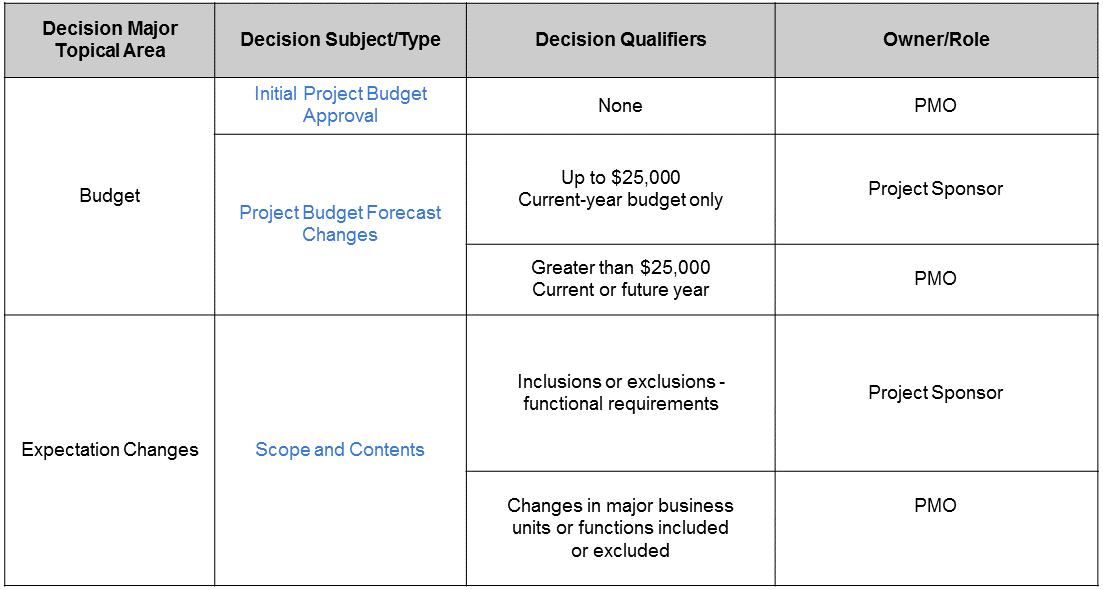How to Build a Decision Rights Matrix for Better Agile Project Management
Teams that practice agile project management (PM) can efficiently incorporate feedback and make quick changes to a project.
However, agile projects are prone to facing the often overlooked threat of too many people in governance positions. This leads to conflicts among the many stakeholders and eventually projects flounder owing to the lack of a defined PM hierarchy.
Small businesses can keep the typical “too many cooks in the kitchen” scenario from creeping up in their projects by creating a decision rights matrix (DRM).
What is a decision rights matrix?
A decision rights matrix is a tool that predetermines many top-level decisions by assigning decision-making authority to specific team members or teams. The templatized matrix can be recycled across several projects to improve accountability and eliminate chaotic processes.
In this article, we will look at how exactly small businesses can create and implement a decision rights matrix (DRM) for their projects.
Here’s what we’ll cover:
Building a Decision Rights Matrix (DRM)
Step #1: Identify the Project Stakeholders
Step #2: Create the Discussion Draft
Building a Decision Rights Matrix (DRM)
Gartner analyst Michael Hanford explains in his article, “Nail Down Program and Project Authority With a Decision Rights Matrix” (report available to Gartner clients only), that the DRM helps businesses establish ownership of “reused decisions” in their projects.
Reused decisions make agile teams more efficient because the same people can come to the same conclusions regarding similar issues—and a DRM helps keep track of these decisions and their owners.
Backlog management, for example, presents many reusable decisions at software development firms that have just begun using Scrum project management tools. In this case, the DRM would help establish a “product owner” who is responsible for defining user stories and prioritizing sprint backlogs.
This results in streamlined processes and the elimination of errors in the final product.
Let’s get into the nitty-gritty of building a decision rights matrix that will suit your business needs.
Step #1: Identify the Project Stakeholders
The first step in creating the decision rights matrix is identifying the project stakeholders. This is critical because it helps you recognize the potential decision owners, which is the ultimate objective of the DRM.
So, how do SMBs identify a project’s stakeholders? Start by listing people (e.g., Project Sponsor) or teams (e.g., Sales) that have influence over and interest in the project.
Influence: Determines how critical the stakeholders are to the successful completion of the project. As influence increases, these stakeholders become more integral to the actual completion of work.
Interest: Determines how engaged the stakeholders are to a project. As interest increases, communicate updates with these stakeholders more thoroughly and frequently.
An easy way to understand the influence and interest of stakeholders is by placing them in a project stakeholders quadrant:

A version of this image originally appeared in this report: “How to Effectively Manage and Engage Project Stakeholders“
The above quadrant is a generic example that highlights possible project stakeholders for growing small businesses. It includes the following:
Project Sponsor: The Project Sponsor is an intermediary between the project manager and the top management. This stakeholder is responsible for procuring resources and ensuring the project aligns with strategic business plans.
The Project Sponsor (has high influence) steers projects to completion and (has high interest) constantly communicates with the project manager.
Project Management Office (PMO): The PMO is a business unit that helps to establish project management (PM) standards in an organization.
The PMO (has high influence) guides managers in the implementation of projects but (has low interest) communicates less frequently than the Project Sponsor.
Sales: The Sales department is responsible for selling a company’s products or services.
The Sales team (has low influence) doesn’t directly contribute to a project’s outcome but (has high interest) needs regular project updates that affect the company’s operations.
Contractor: The contractor is a third-party person or firm offering services to a company.
The Contractor (has low influence) isn’t critical to the success of projects and (has low interest) doesn’t expect regular communication.
The above example lists four common project stakeholders. You’ll need to customize the quadrant based on the relevant project stakeholders in your organization.
Once that’s done, you can start creating the discussion draft, in which you’ll refine this list, trimming it down to identify the decision owners for individual projects.
Step #2: Create the Discussion Draft
In order to arrive at the final product that fits your business, you’ll need to start with a discussion draft, that covers these four components:
Topical areas
Decision types
Decision qualifiers
Decision owners
Below is a short brief on each of these four components to help you work out a DRM for your business.
Decide the topical areas. Topical areas are the known and unknown project requirements for which you need to assign decision owners.
A common topical area for small businesses is the Budget. Expectation Changes (what the project will include and exclude) is another key area for which you need decision owners.
There can also be topical areas unique to a situation—if a small business is building new software features based on the request of customers, Feature Upgrades would be an appropriate topical area.
Understand the decision types. Decision types break down a topical area into specific categories.
Breaking down the topical area is important for a small business because it gives further clarity on who the decision owners should be.
The topical area Budget can be divided into decision types, such as initial project budget approval—the money allocated to a project at the beginning—and project budget forecast changes—the money allocated for any unforeseen changes in the project.
Pick out decision qualifiers. Decision qualifiers help you drill down into decision types and explore them in greater detail.
To understand what the decision qualifiers are for a project, you can look at past experiences.
Start by looking at the causes of why certain past projects stalled or failed. If you find budget limitations as one of the prime causes, adding budget limit as a decision qualifier makes sense moving forward.
Identify the decision owners. Decision owners are the final authority when it comes to making decisions to a project’s topical area.
Small businesses must be wary of defining decision rights for too many tasks in agile processes. Instead, pre-program a number of top-level decisions.
To do this, create a custom list of decision owners by revising your project stakeholders quadrant (created above). You’ll match the stakeholders you identify to the above three components while building the matrix—which we’ll cover in the next section.
Step #3: Build the DRM
Now that you’ve completed your drafting, it’s time to organize these thoughts into a straightforward DRM.
Below is an example, where you can see how the decision topical areas “Budget” and “Expectation Changes” can be classified into categories of “types” and “qualifiers.”

_Example of a decision rights matrix
(Source: “Nail Down Program and Project Authority With a Decision Rights Matrix“)_
Looking at project decisions in such a detailed manner helps you assign the correct decision owners and ensure projects move faster.
Defining a project’s decision owners reduces employee stress, especially if you’re a small businesses transitioning to an agile process. The agile worker constantly collaborates, self-manages tasks and adapts to frequent changes in project requirements.
Pushing your team to become self-managing mavericks overnight can burn them out and delay projects unnecessarily.
Use the DRM to simplify the decision-making process and ease team members into fully embracing the agile mindset.
You can use the example above to build your own decision rights matrix. However, you need to make sure that you customize the topical areas, subjects and qualifiers to get a clear idea of who the decision owners should be.
Looking for tools that improve accountability and decision-making in your projects? Call us at (844) 680-2046 for a free consultation with a software advisor.
Overcoming Challenges
Once you’ve created the decision rights matrix, it’s time to bring everyone onboard so that you can have an agreement around it. However, this can be a challenging task.
To ensure that your DRM gets implemented smoothly, you’ll want to adopt the following collaborative workflow:

Identify the right decision owners: Decision owners are the individuals who are critical to a project’s success. In your research, justify what personality traits and skills of the selected decision owners are the success factors and then build a consensus around that.
Discuss with a small group: To get your decision rights matrix implemented, you need the approval of the leadership with whom you share the discussion draft. To make the process less contentious, keep this group small.
Improve based on feedback: No matter how carefully you plan, you might still encounter objections to your DRM. A simple way to counter this is to let everyone know that the document is open to improvements and not a one time discussion—schedule DRM review dates so colleagues can prepare their feedback and help in improving project governance.
Conclusion and Next Steps
Once the decision owners have been allocated, you need to ensure that everyone follows it. Sending out reminders about who the decision owners are before you start a project is one way to ensure that everyone follows protocol.
The other is to hold periodic reviews and continuously gather feedback from colleagues so that they understand the importance of the DRM to project management.
Here’s a quick summary of what you must do to create and implement a successful DRM for your organization:
Identify project stakeholders who are critical to the project’s success.
Create a discussion draft and outline the four components of the DRM.
Build consensus around the decision owners with the input from a small group.
Review and update the DRM periodically.
To learn more about decision rights matrix and agile project management tools that help you improve accountability in projects, give us a call at (844) 680-2046 for a free consultation with a software advisor.